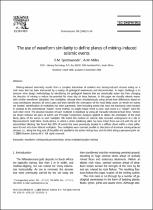JavaScript is disabled for your browser. Some features of this site may not work without it.
- ResearchSpace
- →
- Research Publications/Outputs
- →
- Journal Articles
- →
- View Item
| dc.contributor.author |
Spottiswoode, SM

|
en_US |
| dc.contributor.author |
Milev, AM

|
en_US |
| dc.date.accessioned | 2007-02-06T09:05:16Z | en_US |
| dc.date.accessioned | 2007-06-07T10:02:21Z | |
| dc.date.available | 2007-02-06T09:05:16Z | en_US |
| dc.date.available | 2007-06-07T10:02:21Z | |
| dc.date.copyright | en_US | |
| dc.date.issued | 1998-04-15 | en_US |
| dc.identifier.citation | Spottiswoode, SM and Milev, AM. 1998. The use of waveform similarity to define planes of mining-induced seismic events. Tectonophysics, vol. 289, 03 January, pp 51-60 | en_US |
| dc.identifier.issn | 0040-1951 | en_US |
| dc.identifier.uri | http://hdl.handle.net/10204/1493 | en_US |
| dc.identifier.uri | http://hdl.handle.net/10204/1493 | |
| dc.description.abstract | Mining-induced seismicity results from a complex interaction of ambient and mining-induced stresses acting on a rock mass that has been intersected by a variety of geological weaknesses and discontinuities. A major challenge is to improve mine design methodology by identifying the geological features that are seismically active and then changing the direction of mining to reduce the potential for shear slip on these features. In this paper we classify seismic events with similar waveforms (doublets) into multiplets, relocate them simultaneously using arrival-time differences based on cross-correlations between all event pairs and then identify the orientation of the most likely plane on which the events are located. Identification of multiplets has been automated, even including events that have not previously been located. In contrast to the conventional 'master' event method, no single master event is used: each event is a 'master' event for each other event. The absolute location of each multiplet is stabilised by using all manually selected arrival times. Vectors are drawn between all pairs of events and Principal Component Analysis applied to obtain the orientation of the most likely plane of the events in each multiplet. We tested this method on seismic data recorded underground at a site in Blyvooruitzicht Gold Mine, South Africa, in which a strike stabilising pillar has been mined from one end with the aid of precondition blasting. We found that 39% of events that were previously located in a diffuse cloud within a mine pillar were formed into three distinct multiplets. Two multiplets were oriented parallel to directions of dominant mining-induced stresses, i.e., along the long axis of the pillar and parallel to the active mining face, and the third along a pervasive joint set. | en_US |
| dc.format.extent | 1238744 bytes | en_US |
| dc.format.mimetype | application/pdf | en_US |
| dc.language.iso | en | en_US |
| dc.publisher | Elsevier Science BV | en_US |
| dc.rights | Copyright: 1998 Elsevier Science BV | en_US |
| dc.source | en_US | |
| dc.subject | Waveforms | en_US |
| dc.subject | Mining induced seismicity | en_US |
| dc.subject | Stress multiplet location method | en_US |
| dc.title | Use of waveform similarity to define planes of mining-induced seismic events | en_US |
| dc.type | Article | en_US |
| dc.identifier.apacitation | Spottiswoode, S., & Milev, A. (1998). Use of waveform similarity to define planes of mining-induced seismic events. http://hdl.handle.net/10204/1493 | en_ZA |
| dc.identifier.chicagocitation | Spottiswoode, SM, and AM Milev "Use of waveform similarity to define planes of mining-induced seismic events." (1998) http://hdl.handle.net/10204/1493 | en_ZA |
| dc.identifier.vancouvercitation | Spottiswoode S, Milev A. Use of waveform similarity to define planes of mining-induced seismic events. 1998; http://hdl.handle.net/10204/1493. | en_ZA |
| dc.identifier.ris | TY - Article AU - Spottiswoode, SM AU - Milev, AM AB - Mining-induced seismicity results from a complex interaction of ambient and mining-induced stresses acting on a rock mass that has been intersected by a variety of geological weaknesses and discontinuities. A major challenge is to improve mine design methodology by identifying the geological features that are seismically active and then changing the direction of mining to reduce the potential for shear slip on these features. In this paper we classify seismic events with similar waveforms (doublets) into multiplets, relocate them simultaneously using arrival-time differences based on cross-correlations between all event pairs and then identify the orientation of the most likely plane on which the events are located. Identification of multiplets has been automated, even including events that have not previously been located. In contrast to the conventional 'master' event method, no single master event is used: each event is a 'master' event for each other event. The absolute location of each multiplet is stabilised by using all manually selected arrival times. Vectors are drawn between all pairs of events and Principal Component Analysis applied to obtain the orientation of the most likely plane of the events in each multiplet. We tested this method on seismic data recorded underground at a site in Blyvooruitzicht Gold Mine, South Africa, in which a strike stabilising pillar has been mined from one end with the aid of precondition blasting. We found that 39% of events that were previously located in a diffuse cloud within a mine pillar were formed into three distinct multiplets. Two multiplets were oriented parallel to directions of dominant mining-induced stresses, i.e., along the long axis of the pillar and parallel to the active mining face, and the third along a pervasive joint set. DA - 1998-04-15 DB - ResearchSpace DP - CSIR KW - Waveforms KW - Mining induced seismicity KW - Stress multiplet location method LK - https://researchspace.csir.co.za PY - 1998 SM - 0040-1951 T1 - Use of waveform similarity to define planes of mining-induced seismic events TI - Use of waveform similarity to define planes of mining-induced seismic events UR - http://hdl.handle.net/10204/1493 ER - | en_ZA |






